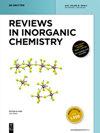2,2 ' -(二氨基)偶氮苯配体的化学性质综述
IF 3.1
3区 化学
Q1 CHEMISTRY, INORGANIC & NUCLEAR
引用次数: 0
摘要
摘要在过去的几十年里,掺入各种偶氮配体的过渡金属配合物引起了人们的广泛关注。另一组研究人员设计了各种多齿偶氮配体,并探索了这些偶氮配体与过渡金属的配位行为。过渡金属螯合物在合成化学中有着广泛的应用。含有偶氮(–N=N-)和甲亚胺(–CH=N-)或亚胺(C=N-)基团的配体骨架为有机金属化学的研究提供了显著的推动力。引入偶氮甲亚胺配体的过渡金属螯合物由于其具有多齿配体的多个配位位点的变体特征而丰富。金属螯合物的通用几何形状及其在各种生活领域的潜在应用为配位化学提供了一个很高的平台。本文综述了一种潜在的偶氮配体2,2′-双(二氨基)偶氮苯及其与d嵌段元素金属配合物的合成策略和配位行为。我们还仔细研究了这些配体在合成化学中的应用以及配体在金属配合物中的偶氮亚胺性质。本文章由计算机程序翻译,如有差异,请以英文原文为准。
Chemistry of 2,2′-(diamino)azobenzene ligand: a brief review
Abstract In the last few decades, transition metal complexes incorporating various azo ligands have drawn much attention. A different group of researchers designed various multidentate azo ligands and explored the coordinating behavior with transition metals of such azo ligands. Transition metal chelates have a wide range of applications in synthetic chemistry. The ligand backbone containing both azo (–N=N–) and azomethine (–CH=N–) or imine (C=N–) groups have gained remarkable impetus for research in organometallic chemistry. The transition metal chelates incorporating azo-azomethine ligands are plentiful owing to their variant features with multiple coordination sites of the polydentate ligands. The versatile geometry of metal chelates and their potential applications in various fields of life has bestowed a high platform in coordination chemistry. The current review covers the synthetic strategies and coordination behavior of a potential azo ligand named 2,2′-bis(diamino)azobenzene and its related ligands with metal complexes of d-block elements. We have also scrutinized the applications of these ligands in synthetic chemistry and the azo-imine character of ligands in metal complexes.
求助全文
通过发布文献求助,成功后即可免费获取论文全文。
去求助
来源期刊

Reviews in Inorganic Chemistry
化学-分析化学
CiteScore
7.30
自引率
4.90%
发文量
20
审稿时长
1 months
期刊介绍:
Reviews in Inorganic Chemistry (REVIC) is a quarterly, peer-reviewed journal that focuses on developments in inorganic chemistry. Technical reviews offer detailed synthesis protocols, reviews of methodology and descriptions of apparatus. Topics are treated from a synthetic, theoretical, or analytical perspective. The editors and the publisher are committed to high quality standards and rapid handling of the review and publication process. The journal publishes all aspects of solid-state, molecular and surface chemistry. Topics may be treated from a synthetic, theoretical, or analytical perspective. The editors and the publisher are commited to high quality standards and rapid handling of the review and publication process.
Topics:
-Main group chemistry-
Transition metal chemistry-
Coordination chemistry-
Organometallic chemistry-
Catalysis-
Bioinorganic chemistry-
Supramolecular chemistry-
Ionic liquids
 求助内容:
求助内容: 应助结果提醒方式:
应助结果提醒方式:


